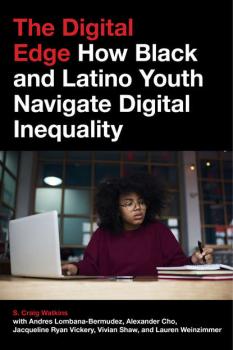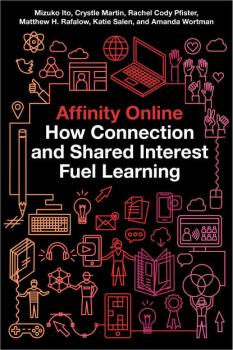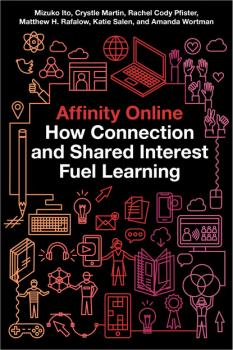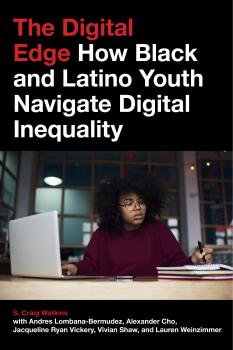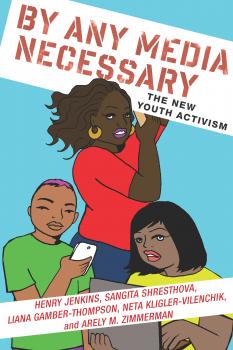ТОП просматриваемых книг сайта:
Connected Youth and Digital Futures
Скачать книги из серии Connected Youth and Digital FuturesАннотация
How black and Latino youth learn, create, and collaborate onlineThe Digital Edge examines how the digital and social-media lives of low-income youth, especially youth of color, have evolved amidst rapid social and technological change. While notions of the digital divide between the “technology rich” and the “technology poor” have largely focused on access to new media technologies, the contours of the digital divide have grown increasingly complex. Analyzing data from a year‐long ethnographic study at Freeway High School, the authors investigate how the digital media ecologies and practices of black and Latino youth have adapted as a result of the wider diffusion of the internet all around us–in homes, at school, and in the palm of our hands. Their eager adoption of different technologies forge new possibilities for learning and creating that recognize the collective power of youth: peer networks, inventive uses of technology, and impassioned interests that are remaking the digital world.Relying on nearly three hundred in-depth interviews with students, teachers, and parents, and hundreds of hours of observation in technology classes and after school programs, The Digital Edge carefully documents some of the emergent challenges for creating a more equitable digital and educational future. Focusing on the complex interactions between race, class, gender, geography and social inequality, the book explores the educational perils and possibilities of the expansion of digital media into the lives and learning environments of low-income youth. Ultimately, the book addresses how schools can support the ability of students to develop the social, technological, and educational skills required to navigate twenty-first century life.
Аннотация
How online affinity networks expand learning and opportunity for young people Boyband One Direction fanfiction writers, gamers who solve math problems together, Harry Potter fans who knit for a cause. Across subcultures and geographies, young fans have found each other and formed community online, learning from one another along the way. From these and other in-depth case studies of online affinity networks, Affinity Online considers how young people have found new opportunities for expanded learning in the digital age. These cases reveal the shared characteristics and unique cultures and practices of different online affinity networks, and how they support “connected learning”—learning that brings together youth interests, social activity, and accomplishment in civic, academic, and career relevant arenas. Although involvement in online communities is an established fixture of growing up in the networked age, participation in these spaces show how young people are actively taking up new media for their own engaged learning and social development.While providing a wealth of positive examples for how the online world provides new opportunities for learning, the book also examines the ways in which these communities still reproduce inequalities based on gender, race, and socioeconomic status. The book concludes with a set of concrete suggestions for how the positive learning opportunities offered by online communities could be made available to more young people, at school and at home. Affinity Online explores how online practices and networks bridge the divide between in-school and out-of-school learning, finding that online affinity networks are creating new spaces of opportunity for realizing the ideals of connected learning.
Аннотация
How online affinity networks expand learning and opportunity for young people Boyband One Direction fanfiction writers, gamers who solve math problems together, Harry Potter fans who knit for a cause. Across subcultures and geographies, young fans have found each other and formed community online, learning from one another along the way. From these and other in-depth case studies of online affinity networks, Affinity Online considers how young people have found new opportunities for expanded learning in the digital age. These cases reveal the shared characteristics and unique cultures and practices of different online affinity networks, and how they support “connected learning”—learning that brings together youth interests, social activity, and accomplishment in civic, academic, and career relevant arenas. Although involvement in online communities is an established fixture of growing up in the networked age, participation in these spaces show how young people are actively taking up new media for their own engaged learning and social development.While providing a wealth of positive examples for how the online world provides new opportunities for learning, the book also examines the ways in which these communities still reproduce inequalities based on gender, race, and socioeconomic status. The book concludes with a set of concrete suggestions for how the positive learning opportunities offered by online communities could be made available to more young people, at school and at home. Affinity Online explores how online practices and networks bridge the divide between in-school and out-of-school learning, finding that online affinity networks are creating new spaces of opportunity for realizing the ideals of connected learning.
Аннотация
How black and Latino youth learn, create, and collaborate onlineThe Digital Edge examines how the digital and social-media lives of low-income youth, especially youth of color, have evolved amidst rapid social and technological change. While notions of the digital divide between the “technology rich” and the “technology poor” have largely focused on access to new media technologies, the contours of the digital divide have grown increasingly complex. Analyzing data from a year‐long ethnographic study at Freeway High School, the authors investigate how the digital media ecologies and practices of black and Latino youth have adapted as a result of the wider diffusion of the internet all around us–in homes, at school, and in the palm of our hands. Their eager adoption of different technologies forge new possibilities for learning and creating that recognize the collective power of youth: peer networks, inventive uses of technology, and impassioned interests that are remaking the digital world.Relying on nearly three hundred in-depth interviews with students, teachers, and parents, and hundreds of hours of observation in technology classes and after school programs, The Digital Edge carefully documents some of the emergent challenges for creating a more equitable digital and educational future. Focusing on the complex interactions between race, class, gender, geography and social inequality, the book explores the educational perils and possibilities of the expansion of digital media into the lives and learning environments of low-income youth. Ultimately, the book addresses how schools can support the ability of students to develop the social, technological, and educational skills required to navigate twenty-first century life.

